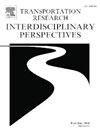A Trip-Chain-based approach to generate travel demands for shared autonomous vehicle systems modeling
IF 3.9
Q2 TRANSPORTATION
Transportation Research Interdisciplinary Perspectives
Pub Date : 2025-04-27
DOI:10.1016/j.trip.2025.101425
引用次数: 0
Abstract
To inform decision making and guide the development of smart transportation systems towards urban sustainability, it is critical to model how travelers may use shared autonomous vehicles (SAV). Such models need two key components − travel demands with high spatiotemporal resolutions and travelers’ sociodemographic information – to determine travelers’ acceptance and participation in SAV system. Existing SAV operations models used travel demand generation methods that either lack travelers’ demographics or only generate trips at a zonal level on a case-by-case basis. A scalable approach that can generate travel demands with higher resolution and linked household- and person-level sociodemographic is needed to enable better analysis of trips’ shareability and support SAV operations modeling. To address this gap, we propose a Household and Individual Trip-chain-based (HIT) travel demand generation model. The travel demands of household members are generated as chains of trips with spatial and temporal details that match the travel patterns of the individual’s as well as the household’s demographic profile. Using Miami as a case study city, we compared the proposed HIT model with a state-of-the-art activity-based model (ABM) to demonstrate its feasibility and validity. Results show that HIT model captures more complex travel patterns. We also used the travel demands generated by both methods as inputs to simulate SAV operation and found that using ABM to input travel demands in SAV operation models may overestimate the benefits of SAVs. Additionally, the proposed HIT model has the advantage of only requiring publicly available data as inputs, making it scalable nationwide.
基于行程链的共享自动驾驶汽车系统建模出行需求生成方法
为了为决策提供信息并指导智能交通系统朝着城市可持续发展的方向发展,对旅行者如何使用共享自动驾驶汽车(SAV)进行建模至关重要。这些模型需要两个关键组成部分——具有高时空分辨率的旅行需求和旅行者的社会人口统计信息——来决定旅行者对SAV系统的接受和参与。现有的SAV运营模型使用的旅行需求生成方法要么缺乏旅行者的人口统计数据,要么只在个案的基础上生成区域层面的旅行。需要一种可扩展的方法,以更高的分辨率生成旅行需求,并将家庭和个人层面的社会人口统计联系起来,以便更好地分析旅行的可共享性,并支持SAV运营建模。为了解决这一差距,我们提出了一个基于家庭和个人旅行链(HIT)的旅行需求生成模型。家庭成员的旅行需求以旅行链的形式生成,其空间和时间细节与个人的旅行模式以及家庭的人口统计资料相匹配。以迈阿密为例,我们将提出的HIT模型与最先进的基于活动的模型(ABM)进行了比较,以证明其可行性和有效性。结果表明,HIT模型能够捕捉到更为复杂的出行模式。我们还使用两种方法产生的出行需求作为输入来模拟自动驾驶汽车运行,发现在自动驾驶汽车运行模型中使用ABM输入出行需求可能会高估自动驾驶汽车的效益。此外,提出的HIT模型的优点是只需要公开可用的数据作为输入,使其在全国范围内可扩展。
本文章由计算机程序翻译,如有差异,请以英文原文为准。
求助全文
约1分钟内获得全文
求助全文
来源期刊

Transportation Research Interdisciplinary Perspectives
Engineering-Automotive Engineering
CiteScore
12.90
自引率
0.00%
发文量
185
审稿时长
22 weeks
 求助内容:
求助内容: 应助结果提醒方式:
应助结果提醒方式:


